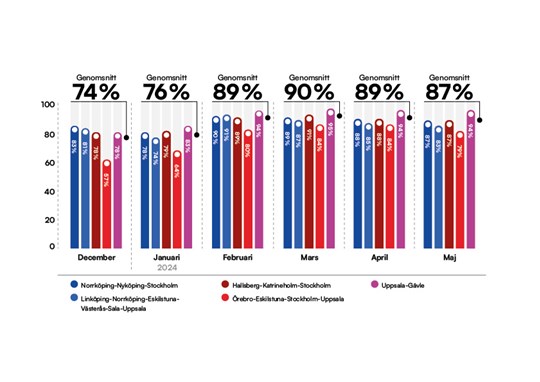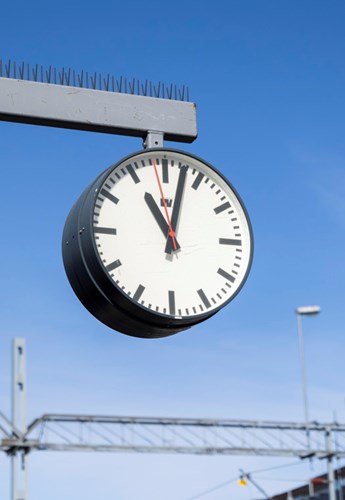Punctuality
Reliable and punctual service with trains running on time is important to increase sustainable travel by regional trains in the Stockholm-Mälaren valley. Here we will regularly report on the punctuality of the regional train services. We report on a monthly basis about the punctuality of the Mälartåg lines.
Mälartåg punctuality
January - May 2024
Mälartåg punctuality January- December 2023
| Örebro-Eskilstuna - Sthlm-Uppsala | Linköping- Eskilstuna- Västerås- Sala-Uppsala | Hallsberg-Katrineholm-Stockholm | Norrköping-Nyköping-Stockholm | Uppsala-Tierp-Gävle | |
| January | 88% | 92% | 86% | 92% | 95% |
| February | 90% | 90% | 90% | 91% | 96% |
| March | 86% | 89% | 88% | 88% | 91% |
| April | 91% | 88% | 89% | 90% | 97% |
| May | 85% | 89% | 88% | 90% | 97% |
| June | 74% | 87% | 86% | 89% | 95% |
| July | 75% | 88% | 90% | 92% | 96% |
| August | 72% | 88% | 88% | 89% | 93% |
| September | 78% | 86% | 91% | 91% | 94% |
| October | 89% | 84% | 88% | 83% | 94% |
| November | 74% | 86% | 85% | 87% | 92% |
| December | 57% | 81% | 78% | 83% | 78% |
|
Total 2023 |
79% | 87% | 87% | 89% | 93% |
2023 in entirety: 87 percent of trains were on time throughout 2023, the same level as in 2022. The traffic reduction in 2023 resulted in a more stable traffic situation and improved punctuality up to May, but declined during the summer and the remaining part of the year. This was due in part to several months of track work following a derailment on the Arlanda line that affected the entire rail network, and an early winter with snow and cold. The intermittently harsh winter led to many infrastructure problems, causing disruptions in traffic and also affecting the availability of vehicles. Read more below about the punctuality for each month.
December 2023: December had the lowest punctuality for passenger trains throughout Sweden for the entire year, according to the Swedish Transport Administration. This also applies to Mälartåg, where punctuality in December was 74 percent. The month was characterized by winter weather with persistent cold and heavy snowfall, requiring efforts such as snow removal and de-icing. The low average punctuality was due to many individual days with long delays. The major incidents causing traffic delays were exclusively due to track and switch failures caused by snow and ice. The cold also caused problems for our trains, and several trains from other operators were stranded on the line, causing disruptions.
November 2023: Punctuality decreased by 2% to 85% compared to the previous month, and the main reason for this was the significant number of disruptions that occurred in November due to infrastructure issues. There have been several incidents of track and switch faults along the route between Stockholm and Uppsala, as well as switch faults near Södertälje. These incidents have resulted in delays affecting large portions of the Mälartåg system. The heavy snowfall at the end of the month primarily impacted the infrastructure and led to additional delays. Additionally, there have been a small number of door-related issues during the month, contributing to further delays.
October 2023: Punctuality has been low during the autumn. In October, punctuality decreased by 1 percentage point to 87% compared to September. Primarily, infrastructure faults and accidents caused delays in traffic. A widespread power failure in the Stockholm area led to power outages on several routes. All trains, both northbound and southbound, were affected. Signal and switch faults have occurred in several places. There have also been many accidents, primarily involving collisions with wildlife.
September: Punctuality increased by 2% in September compared to the previous month. The ongoing work on the Arlanda Line continued to impact the punctuality of train services between Uppsala, Stockholm, Eskilstuna, and Örebro. The primary causes of disruptions during the month were infrastructure issues. At the beginning of September, there were signal problems at Stockholm Södra station, affecting several Mälartåg trains. On the Uppsala to Gävle line, trains were delayed due to a switch malfunction. Midway through the month, a contact wire incident occurred between Eskilstuna and Arboga, and at the end of the month, a major signal fault at Örebro Södra station disrupted train services. Additionally, several wildlife accidents occurred, further impacting train operations.
August 2023: Mälartåg's punctuality decreased by 2% compared to the previous month, reaching 86%. The derailment of Arlandabanan and subsequent track work caused delays on the Örebro-Eskilstuna-Stockholm-Uppsala route, impacting Mälartåg's overall punctuality. In August, the traffic was affected by natural events such as floods, high water flows, and the risk of landslides. Signal faults at Stockholm Södra disrupted most of Mälartåg's lines, and a damaged overhead line at Skebokvarn also affected train traffic.
July 2023: The average punctuality of Mälartåg increased by two percentage points compared to the previous month, reaching 88 percent. The previous derailment on the Arlanda Line continued to affect traffic through speed reductions on the stretch. In addition to ongoing track work impacting punctuality, there were also several accidents, a downed overhead contact line near Södertälje, and thunderstorms causing disruptions in the infrastructure.
June 2023: The overall punctuality of Mälartåg for the month of June reached 86%, which is a decrease of 5 percentage points compared to the previous month. The low punctuality on the Örebro-Eskilstuna-Stockholm-Uppsala line, primarily due to restrictions at Arlanda, and has a significant impact on the average punctuality of Mälartåg's lines.
May 2023: The punctuality of Mälartåg trains was 91 percent in May, a decrease of 1 percentage point compared to April. Several major incidents caused disruptions in the traffic, including the derailment of an Arlanda Express train on the Arlandabanan line on May 27, signal and switch failures at multiple locations on multiple occasions, and a barn fire in Järna that halted all train traffic between Södertälje and Järna.
April 2023: The punctuality of Mälartåg trains increased by 3 percentage points to 92 percent in April, reaching the same levels as at the beginning of the year. The milder temperatures contributed to improved punctuality by avoiding major weather events. However, there were some disruptions in train traffic, mostly caused by various train operators, as well as due to ongoing track maintenance between Örebro and Arboga and a longer traffic stop in Eskilstuna.
March 2023: The overall punctuality for the month of March show variations between weeks, and peaked over 90 percent at the start of the month to land at 89 percent at the end of the month, a setback of 3 percentage points compared to the month of February. The month was marred by a number of various disruptions in traffic, everything from signal and switches failures to severe cold and heavy snowfall.
February 2023: Overall punctuality for Mälartåg remained at 92 percent during the month of February - the same level as in January - as a result of the adapted timetable which was introduced in December 2022. A major electrical malfunction in Stockholm caused problems for traffic and many accidents and falls by unauthorized persons in the track area led to traffic stoppages in several places. A number of signal faults and railroad switch faults as well as some minor vehicle faults contributed to delays during the month.
January 2023: The total punctuality of Mälartåg landed on 92 percent in January, an increase of 4 percentage points compared to December 2022. The increased punctuality applies to all lines and is largely due to the new adapted timetable with reduced traffic on several routes. Unauthorized persons in tracks, wildlife accidents and gear failures caused delays, as well as some vehicle failures.

